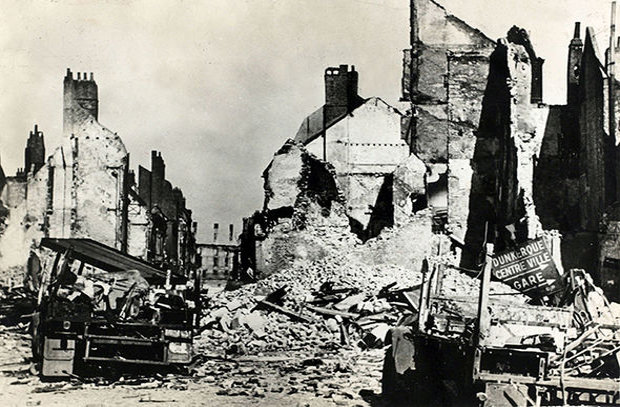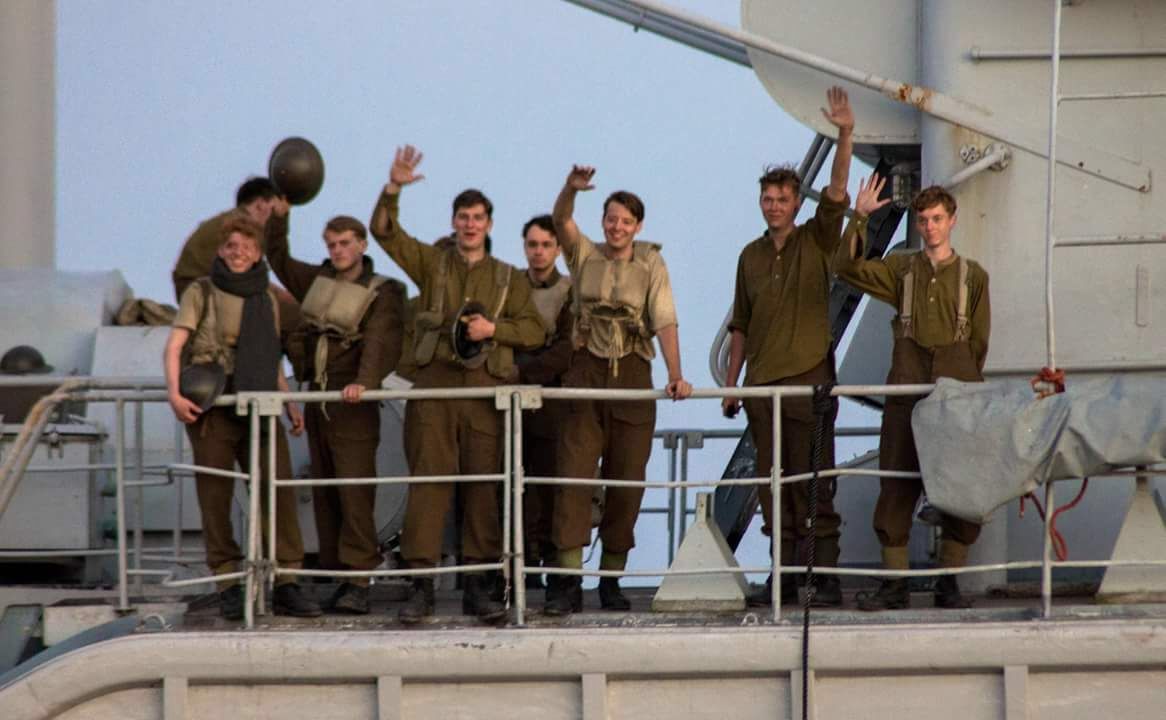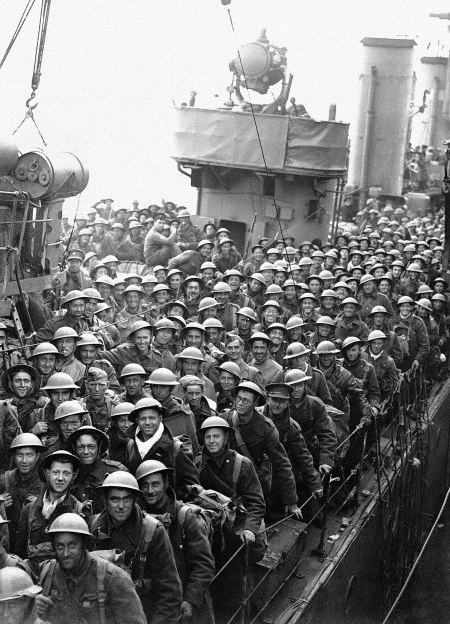IMDb metadata: 1 Hour and 47 minutes. 8.1/10 @ 312,875 Opinionators
How could such a tired, clichėd, and disjointed movie be made of this event? That it ranks highly as shown above only indicates the audience. I put off watching it knowing I would find the historical inaccuracies a pain. Right again.

Why do the inaccuracies matter anyway? Isn’t it just a movie? Afraid not.
I have heard far too many people refer to movies for historical facts. None of the half a dozen reviews I read after watching it made any reference to historical reality. Yet many viewers, most viewers will take it just that way.
In short, both John Mills in ‘Dunkirk’ (1958) and Jean Paul Belmondo in ‘Week-end à Zuydcoote’ (1964) had better material and played it better.
What’s to like? It makes a short list.
It just starts. Bang. No information card. No voiceover. That makes it a fast and clean start. Good, let the ride begin.
The cinematography steals the show, especially in aerial scenes, and I am sucker for that. The best I have seen since ‘The Dark Blue World’ (2001) and before that ‘Piece of Cake’ (1988).
Some of the acting is up to the ‘Mrs Miniver’ (1942) standard, notably on the small boat, but most isn’t.
There is a high blood pressure soundtrack which too often competes with the screen. A mute button was needed for that. If the visceral reality is the point, then let’s hear that as the men did.
I also like that it is feature length and not an epic of endurance for the viewer!
What’s not to like is a longer list.
Overall we get nothing about the human side of it, the decision-making, Belgian, English, French, or German. Without that, it becomes a disaster movie where an uncontrollable force of nature erupts and a mix of individuals try to survive. It could have been played without a word of dialogue and that might have improved it.
This impression grows because we never see a German until a few shadows in the last scene. The unseen enemy becomes a malevolent storm, not other fallible human beings.
Likewise most of the characters are nameless ciphers. Though, curiously, some of the nameless are named in the credits. Confusing or confused? Pick one!
By default the movie also makes the evacuation seem disorganised but in fact the staff work to organise and plan was extensive and that is largely why it was as successful as it was. I have mentioned this is another post on this blog. The essential point is that it was ten, that is, 10 x, more successful than early estimates, most importantly including those made by the Germans.
Here are a few IS, that is, Irritating Specifics.
At the beginning, the five Brits amble down the street; they are too clean. They dawdle. There is no urgency. After at least five weeks in the field they are clean. Ah huh. They might have 2018 fashionably long hair after weeks in the field but they would also be unshaven and dirty with torn and soiled uniforms. This impression is not mitigated by a few close ups of dirty hands. Nor would they amble at this juncture. They dawdle for no other reason than to have the idyl broken by gun fire. Very staged and it is obvious.
The town of Dunkirk is shown tidy in the film when in fact it was rubble by the time the BEF got there. ‘BEF?’ That is, the British Expeditionary Force, as it was called.
 The reality.
The reality.
Dunkirk was held to anchor the flank and it was devastated, a ruin, not a ghost town as presented here. This is an important point because the French did fight hard in the North, particularly around nearby Lille which was also flattened. The defence of Lille delayed the German advance in the North making the evacuation possible.
The mountain of sandbags is impressive and pointless. Who had the time to build it? And why bother? Manned by only three poilus, who are not even going to slow up a German patrol. Nor is it likely they would know about the evacuation. Master plans from London are seldom passed onto to isolated French riflemen like the uncredited Daniel Auteil. Moreover, more than 100,000 French were evacuated, some in French ships usually omitted from English telling of this story, though some of the ships we see in this film with British flags are French. Confusing, non?
Branagh does a lot of posing and takes off his hat for no other reason than the look. Who he is and what he is doing, apart from posing, is left to guesswork.
Why does the loaded hospital ship stay on the pier long after it is declared full? By the way it clearly was not full.
 This ship is full, not.
This ship is full, not.
 This ship is full.
This ship is full.
Indeed the crowd in this film was often sparse. Except for a few scenes there were not many extras. The whole cast might has well have been CGIs given how little humanity is allowed to them.
While on matters nautical the destroyers do not seem to have anti-aircraft Bofors guns but the I-class ships did and they were the ones there.
The men who take refuge on the beached Dutch trawler make a sitting target for a Stuka bomb attack. Surely they would have known that. Nor do they take the simple precaution of posting a sentry. Why someone getting off would plug the holes in the hull is anyone’s guess. Yes, I know stress does bend the mind, but it does not enlist sympathy.
The choreographed cheering looks just like that. The news does not travel down the line but erupts all at once, clearly on cue. Moreover, most men on the beach were hiding in the dunes out of sight to avoid being targets for air attack until ships were available so they would not have seen much.
Nor did Branah have to wait for the French as the Irishman says in closing, because after the first day Churchill, unseen in this telling, ordered first come first served and about 100,000 French and Belgians were lifted to continue the war.
The aerial choreography was grand but full of inaccuracies. The Messerschmidts did not have yellow nose cones to make them easy to identify. The Spitefire carried ammunition for one 20-second burst, or divisions thereof. To hit anything they had to close to one hundred yards or less so that the target filled the target ring. This Spitefire has nearly forty minutes of ammunition. Moreover, after all the early fuss about fuel, the last one has a bottomless tank. Nor does the Spitefire have the endless glide path shown. With the engine, weapons, and pilot in the front, it was front heavy.
Yes, the Tommies on the beach did decry the lack of air cover but surely they would not have said ‘airforce,’ but RAF. Was it a marketing decision to script it as ‘air force’ in case some viewers did not know what RAF is? The RAF did want to preserve assets for the next round until Churchill overrode it. The limitation was distance and also guessing when the Luftwaffe would be there to attack.
The Luftwaffe did not have to go out in the Channel to engage the RAF. Why do so? The RAF attacks were limited by range and were as unpredicable as the German ones, while the beaches and waters were full of big targets.
Unlikely Heinkels were much used there but applied elsewhere to the main German drive, contrary to the myth, was miles away toward Paris with many stationery targets like railway yards, bridges, etc. For Heinkels to hit a moving ship with a bomb is a script writer’s dream.
The Channel is too shallow for U Boats and Dunkirk was a resort town because of the shallow waters which kept the destroyers out to sea but made loading small boats easy. Shallow water made submarines easy to spot from the air.
Of course, a Heinkel might have been there, ditto a U Boat. The point is the film is pastiche of incidents with no coherent story line. Looks like someone did a lot of reading and picked out of context a diversity of incidents for their cinematographic potential and then strung them together, not to convey what happened but to hop from one tableau to another and back. The result is a series of incoherent images without rhyme or reason. There is neither plot nor character. And as noted a couple of times above, the direction is stiff.
Yet no doubt some viewers will conclude that they know the history now.
It is heartening to see that some user reviews on IMDB are negative, despite the average rating. Unlike the professional critics who carefully avoid ruffling any feathers. I pine for a Pauline Kael destruction of this nonsense.
Skip to content
